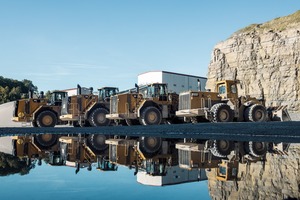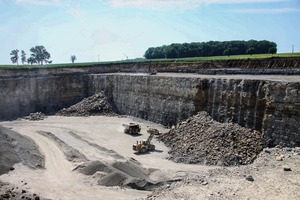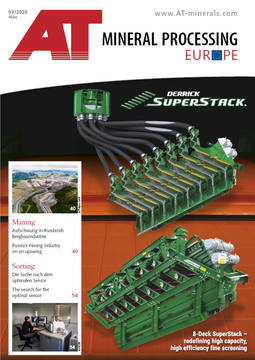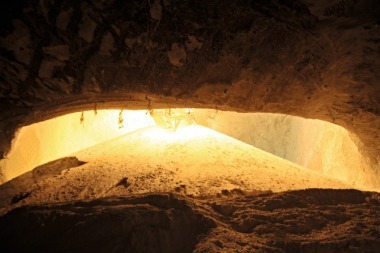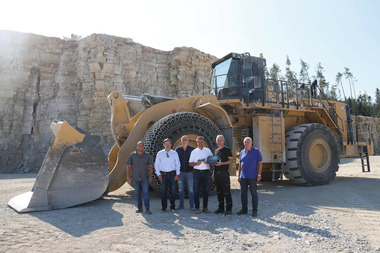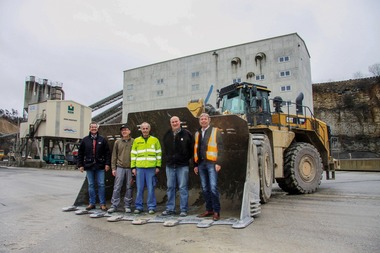Four generations of wheel loader now united at Steinbruchbetrieben Hohenlohe Franken
The results of trial, set to run for two weeks, were convincing and revealed considerable fuel savings. “It’s true what Caterpillar claims: the wheel loader uses 25 % less fuel,” says Klaus Schneider, Managing Director at SHF. The results were determined with four different drivers in otherwise homogeneous test conditions. At SHF, always the same material is loaded from a closed wall. Every loading machine is equipped with rock tyres, although no chains are fitted. Shell limestone does not have sharp edges. The tyres together with their tread and sidewalls do not have to be explicitly protected against damage and abrasive cuts.
“In our trial, all the drivers needed 10 l less compared with the K series,” explains Schneider. While the K-series loaders achieve an average of just under 42 l, with the XE machine consumption could be lowered to 32 l. “Our best driver even got down to 29 l with the diesel-electric wheel loader. Striking, too, was that from the second day every operator was so steady in the saddle that the 30-l mark was certainly realistic,” says the managing director, convinced of this. But other aspects could gain importance in the future: if a tax on CO2 emissions is introduced, other drive systems like diesel electric would become more attractive to lower their level.
Besides fuel consumption, SHF regularly trials the idle times. For this purpose, Klaus Schneider uses the fleet management from Caterpillar and the Zeppelin customer portal for evaluation. “From time to time, a wheel loader operator has to clean the crusher, and in the past just left the machine running. That was not without consequences. Now we have activated the motor automatic switch-off and shortened the idle times.”
SHF was established as a company in 1998 from a quarry that was actually abandoned in 1993. It was formed following the merger of three companies from Rothenburg ob der Tauber, Gammesfeld und Schmalfelden. Production at the Bettenfeld site was initially shut down – the extraction site was only supposed to be used for backfilling. But that would have been a waste of resources – the value of the raw material available was too high. For this reason, the decision was taken to apply for quarrying permission on an extraction site covering more than 50 hectares for 30 years.
Every 10 000 operating hours, the machines are changed over: new technology moves to the extraction front while the old machine takes over any downstream work – for example in backloading. Or it loads dumper trucks with material mixed with a small content of clay for which there is no use. This material is then backfilled by off-road trucks at the quarry.
At the closed 200-m-long wall, a Cat 988K with its 7.5-m³ sawtooth bucket currently loads the shell limestone loosened by blasting onto two new 775G off-road trucks in five loading cycles. For a while, three dumper trucks were planned. With the relocation of the semi-mobile crusher in the direction of loading point and the installation of an around 600-m-long conveyor belt in 2015, the machines no longer have to travel more than 1 km, but just 500 m. At the beginning, 50-t dumpers were used, then the payload was increased by 10 t. Accordingly, the number of trucks used could be reduced from three to two. The two new 60-t dumper trucks only went into operation a few weeks ago. They were adapted to the loading work with a 30-cm increase in the tailgate height so that they can take up more material.
“In the meantime – driven by the order situation – production has steadied at 900 000 t/a, but that could easily turn into 1 mill. t. It is possible to achieve the production goal because the operation with its 18 employees can react flexibly. Depending on the sales level, work is done in 1.5- to 2-shift operation between 6 am and 7 pm. In 2019, we started production early on and the prospects for the autumn are very promising,” says Schneider.
Extraction extends over the area rather than over the depth in Bettenfeld – per year, SHF needs an area of 1.6 to 1.7 hectares. Overburden makes up around 6 to 7 m. Extracted are the top 30 m. There are geological reasons for this. “If we were to go deeper, we would immediately land in the groundwater. So we limit ourselves to the choice pieces and achieve high-quality production,” Schneider explains. The extracted material is refined in processing. 60 % of the products are intended for road construction and civil engineering. This includes material in the quality class KG1 for the railways, but also for the construction of motorways as the gravel base layer under concrete. “We supply around 300 000 t for concrete construction,” says Schneider. 35 % of the extracted material is destined for chippings, which are used in the production of concrete but also in the road surfacing of motorways. The rest falls into the category of speciality products, is used in hydraulic engineering, gardening and landscaping or processed to fertilizer lime.

